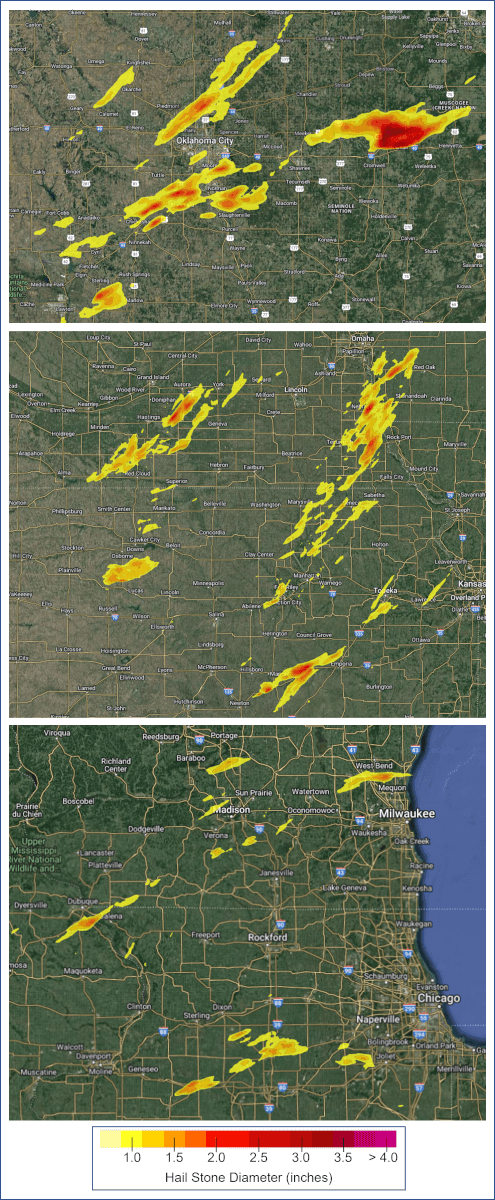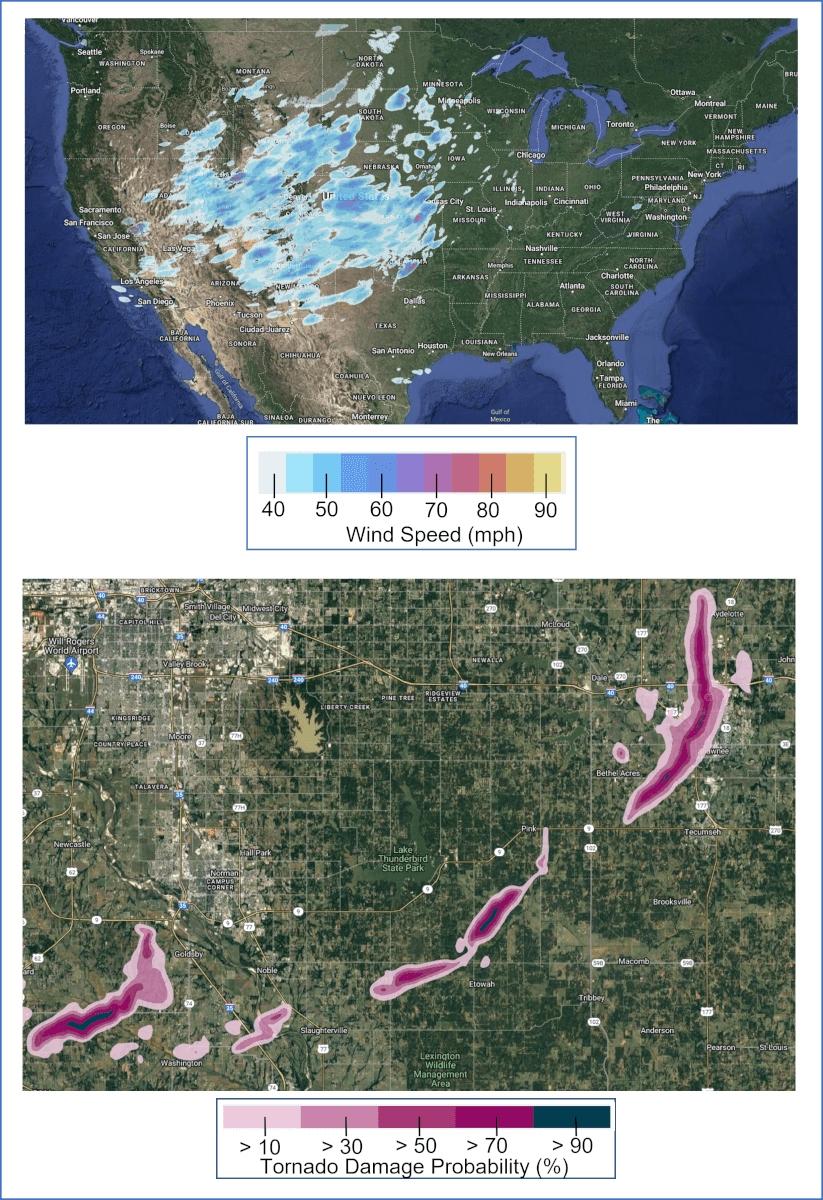CoreLogic estimates 413,013 homes may have sustained hail damage
A band of severe thunderstorms crossed the central U.S., starting Wednesday, April 19, and continuing through the night. Large hail, multiple tornadoes and powerful straight-line winds damaged property from Oklahoma to Wisconsin. According to the National Oceanic and Atmospheric Administration (NOAA) Storm Prediction Center (SPC) Filtered Storm Report for April 19, this severe thunderstorm system was responsible for more than 200 tornado, large hail and high wind reports across the country.
Severe thunderstorms in the U.S. are responsible for substantial property damage this year, including numerous outbreaks in March and April. For information on previous severe thunderstorm damage, including that from tornadoes and large hail, visit CoreLogic’s Hazard HQ.
CoreLogic Identifies 413,013 Homes Worth an Estimated $127.9B Within Hail Swath Boundary
CoreLogic® Weather Verification Services (WVS) and the Reactor™ Platform captured the impact of hail swaths across the U.S. on April 19. The most severe hail – classified in terms of hail diameter – fell in Oklahoma, Kansas and Iowa. In Oklahoma, 4-inch hail was recorded in Okfuskee County, Oklahoma, east of Oklahoma City, and 2.75-inch hail was recorded in Oklahoma County just north of Oklahoma City. Hail surpassing 2.5 inches in diameter was recorded between Wichita, Kansas and Omaha, Nebraska.
CoreLogic estimates that hail greater than 1 inch in diameter likely impacted approximately 413,013 single- (SFR) and multifamily residential (MFRs) properties across the country with a combined reconstruction value (RCV) of $127.9 billion.
Below, Table 1 provides the total number and RCV of residential properties by hail diameter. The count and RCV totals are provided by state (Table 1.1) and by county for the five hardest-hit counties (Table 1.2). Figure 1 provides a map of the hail swath boundaries and intensity (i.e., hail diameter), as visualized in CoreLogic’s Reactor platform.
| State | Count | Total RCV (USD billions) | ||||||
| 1″ – 2″ | 2″ – 3″ | > 3″ | Total | 1″ – 2″ | 2″ – 3″ | > 3″ | Total | |
| OK | 265,396 | 22,628 | 372 | 288,396 | 79.3 | 6.9 | 0.1 | 86.3 |
| NE | 5,225 | 3,696 | – | 8,921 | 1.4 | 1.0 | – | 2.4 |
| IA | 16,596 | 1,593 | – | 18,189 | 4.7 | 0.4 | – | 5.1 |
| TX | 11,038 | 1,323 | – | 12,361 | 3.1 | 0.4 | – | 3.5 |
| IL | 34,060 | 530 | – | 34,590 | 13.9 | 0.2 | – | 14.1 |
| KS | 24,192 | 172 | – | 24,364 | 7.4 | – | – | 7.4 |
| WI | 25,230 | – | – | 25,230 | 8.8 | – | – | 8.8 |
| SD | 948 | – | – | 948 | 0.3 | – | – | 0.3 |
| MO | 14 | – | – | 14 | <0.1 | – | – | – |
| Grand Total | 382,699 | 29,942 | 372 | 413,013 | 118.9 | 8.9 | 0.1 | 127.9 |
Table 1.1: Residential Property Count and Total Reconstruction Value ($USD Billions) by State Number and RCV of Single- and Multifamily Residentia Properties by Hail Diameter Within the Hail Swath Footprints
| County | Okfuskee | Grady | McClain | Oklahoma | Canadian | |
| State | OK | OK | OK | OK | OK | |
| Count | 1″-2″ | 1,117 | 10,035 | 6,046 | 146,151 | 21,861 |
| 2″-3″ | 1,036 | 2,465 | 1,621 | 14,043 | 3,156 | |
| >3″ | 150 | 139 | 83 | – | – | |
| Total Count | 2,303 | 12,639 | 7,750 | 160,194 | 25,017 | |
| RCV (USD billions) |
1″-2″ | 0.2 | 2.5 | 1.9 | 46.5 | 6.4 |
| 2″-3″ | 0.2 | 0.6 | 0.4 | 4.5 | 1.1 | |
| >3″ | < 0.1 | < 0.1 | < 0.1 | – | – | |
| Total RCV | 0.4 | 3.1 | 2.3 | 51.0 | 7.5 |
Table 1.2: Residential Property Count and Total Reconstruction Value ($USD Billions) by County Number and RCV of Single- and Multifamily Residential Properties by Hail Diameter in the Top Five Most Heavily Impacted Counties by Count and Hail Diameter

Materials Matter Regarding Hail Damage
Generally, a hailstorm is a vertical load that causes severe damage to roofs, walls and openings (e.g., skylights, windows and doors). According to an evaluation of property insurance claim data in Dallas-Fort Worth, written by Brown et al., 2015 and cited in CoreLogic’s U.S. Severe Convective Storm Model documentation, damage to roofs accounted for 91.7% of the total number of claims during the hailstorm that prompted the study. Damage to walls, doors and windows accounted for a combined 2.3% of the total number of claims from the same event.
Roofing material factors heavily into whether hail will damage a property’s roof. According to Brown et al., 2015, asphalt shingling has a hail diameter size damage threshold of 1 inch, compared to concrete tiles, which have a hail diameter size threshold of 2 inches.
Additionally, roofs can be rated for impact resistance on a scale of one to four, with roofs of a higher rating being more resistant to hail-related damage.
Disclaimer: Please note that not all properties within the hail swaths sustained damage. Additionally, the degree of damage to structures may vary, as a damaged structure may not have incurred a total loss equal to the full RCV. The number of damaged properties will be a subset of the total homes within the hail swaths.
What constitutes a “Severe Thunderstorm,” And What Happened on April 19?
According to the NOAA National Severe Storm Laboratory (NSSL), there are around 100,000 thunderstorms in the U.S. each year, approximately 10% of which become severe thunderstorms. Severe thunderstorms are most frequent in the spring and summer months.
Thunderstorms occur with the right combination of moisture and rising, unstable air. These storms are considered severe if the system produces either hail greater than 1 inch in diameter, winds greater than 57.5 mph or tornadoes.
On April 19, CoreLogic WVS and the Reactor platform captured the straight-line wind fields and tornado paths across the U.S. The straight-line wind maps and tornado footprints as viewed in Reactor are presented in Figure 2 below. Users can download wind speed and hail size maps (i.e., ESRI Shapefiles) directly from CoreLogic WVS to manage exposure at risk from the April 19 severe weather outbreak.

Visualize Hazard Footprints and Manage Your Portfolio with Reactor
CoreLogic Reactor is an interactive, geospatial mapping solution that provides forecasting and real-time and forensic weather data to users – all from a single platform. Users can visualize storm warnings, watches, alerts and impacts of a weather event in the aftermath of activity. Such data includes tropical storm and hurricane wind speeds at the parcel level.
Tornado path and hail swath visualizations are powered by CoreLogic WVS. CoreLogic WVS combines the best aspects of point observations — providing a high degree of accuracy — and radar technology high-resolution patterns. Proprietary algorithms generate wind speed maps with a high degree of geographical precision at the neighborhood-level detail (500-meter resolution). These digital tools offer 100% coverage of the continental U.S.
To learn more about severe convective storm risk in the U.S., download the CoreLogic 2023 Severe Convective Storm Report.
Please email [email protected] with questions regarding the April 19 severe weather outbreak, Weather Verification Services, the Reactor platform or any CoreLogic event response notifications.
Visit www.hazardhq.com for updates and information on catastrophes across the globe.


